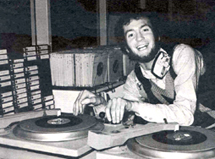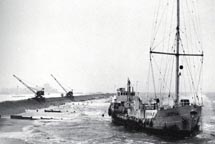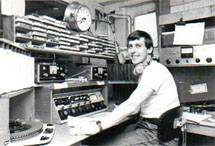 SVENSKA RADIOARKIVET
radioarkiv@gmail.com
SVENSKA RADIOARKIVET
radioarkiv@gmail.com
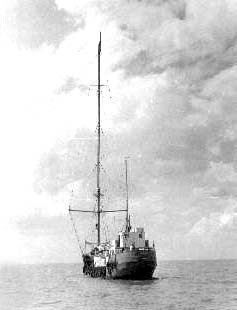 |
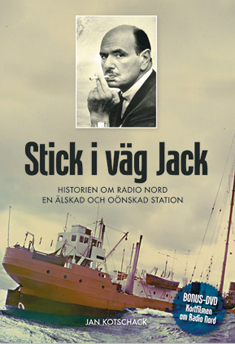 |
STICK
IVÄG JACK "Hit the road Jack" |
| The thrilling story about Radio Nord, its founder Jack Kotschack and a very different Sweden. |
| Richly
illustrated with loads of never before published pictures. The book comes with a unique DVD including a documentary film about Radio Nord which was shown as an opening film at the Swedish cinemas in autumn 1961. |
| Out
now $55.00 Read more |
| + KLIF, Dallas, January 4, 1961 The Ken Lock show. |
| + KLIF, Dallas, 1962 Russ "Weird Beard" Knight show. |
| + KLIF, Dallas, March 3, 1962 The Murphy & Harrigan Show. Tom Murphy and "Irving Harrigan" (Ron Chapman). 8:00 - 9:00 a.m. |
| + KLIF, Dallas 1962 jingles |
+ WOR-FM, Barry Farber in 1963 An interview with Radio Nord's Jack Kotschack. |
+ WMCA-New York in 1963 B. Mitchell Reed. |
+ WABC, New York, springtime 1965 American
Top 40 radio with PAMS jingles and the unrivaled legend Dan
Ingram. |
| Three
recordings with unknown dates: |
+ WABC, New York 1968 studio quality |
| + scanning the dial in NYC, July 1, 1969 Starting on WABC, AM 770 kHz. |
| + WABC, New York, April 1, 1972 Dan Ingram. |
| + K100 (KIQQ) in 1974 Beaver Cleaver (Ken Levine). |
| + KFRC-AM610 September 8, 1974 Dr. Don Rose (Donald Rosenberg) - four times he made KFRC selected as Billboard's "Station of the Year" and he was personally named "Disc Jockey of the Year". Click here for further reading |
+ KFRC-AM610 April dd?, 1976 Dr. Don Rose (Donald Rosenberg) |
| + KFRC-AM610 Sept 28, 1978 Dr. Don Rose (Donald Rosenberg) |
| + KFRC-AM610 May 30, 1980 Dr. Don Rose |
| + KFRC-AM610 Oct. 21, 1980 Dr. Don Rose |
| + KFRC-AM610 December dd?, 1980 Dr. Don Rose |
+ KFRC-AM610 STEREO May 14, 1986 A recording of AM stereo using the Motorola C-QUAM system. On the subject of AM stereo: click here for further reading |
| + KROQ FM, March 1984 - "The Swedish Egil" (Egil Aalvik ) |
| + American Top 40, August 24, 1974 Casey Kasem's production of "American Top 40" not quite complete. |
|
+ American Top 40, Feb 28, 1987 Casey Kasem's American Top 40 in a complete 4 hours 14 minutes recording. Click here for further reading |
|
+ WTIC FM 96, Hartford, Conn. |
|
+ WTIC FM 96, Hartford, Conn. |
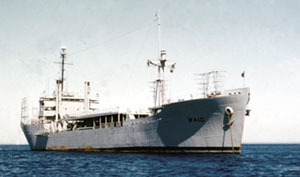 The United States coast guard cutter "Courier", a 338-foot, 5,500 ton vessel, moored off Rhodes, Greece. A mobile transmitting facility for the U.S. Information Agency to broadcast the "Voice of America" programs behind the "Iron Curtain" in "The Cold War" years. |
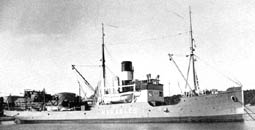 An image of the salvage ship Herakles, owned by the Neptune Company which Jack initially saw as an appropriate choice to be rebuilt as broadcasting ship for Radio Nord. |
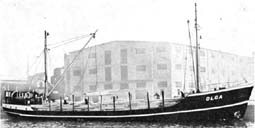 The original "Olga" moored in the harbor of Kiel before conversion. |
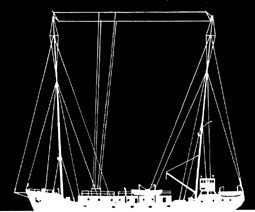 A graphic image showing the design of the Bon Jour as she was planned to be, a two-masted broadcast ship |
The
texan owners of the Bon Jour had already begun to spread the word: |
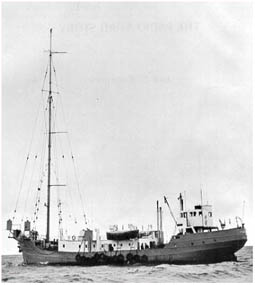 The Bon Jour, fitted for broadcasting purposes |
 Engineer Roland Englund behind the transmitter |
 This was the planned route for the voyage from Copenhagen and up north to the Stockholm archipelago. |
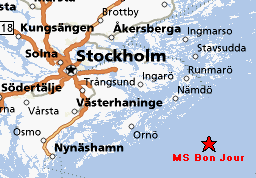 When they chose a possible anchorage for Bon Jour, they had to take into account that the Nynäshamn port had a duty station and it was possible for the tender to start in the morning after they opened and to reach out to Bon Jour and return back to Nynäshamn before the customs station closed for the evening. |
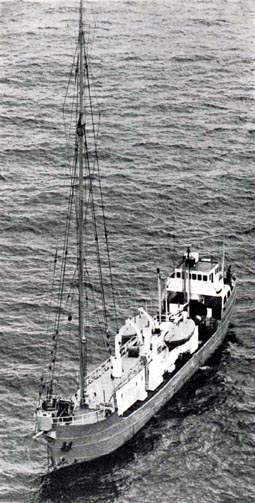 On this early image there is only one of the typical antenna tuning boxes and we see that it's mounted above the bowsprit. In the final embodiment there were a total of three such tuning boxes. |
 Here is another image where there are three tuning boxes. |
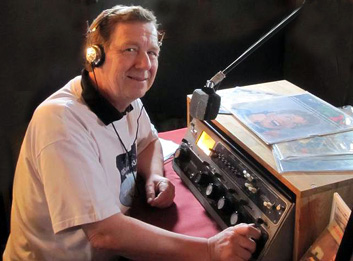 |
Hello
all radio enthusiasts |
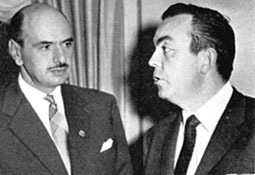 Jack S Kotschack and Gordon McLendon |
||||
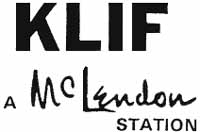 |
||||
|
+ KLIF, Dallas, January 4, 1961 The Ken Lock show. |
||||
|
+ KLIF, Dallas, 1962 Russ "Weird Beard" Knight show. |
||||
| + KLIF, Dallas, March 3, 1962 The Murphy & Harrigan Show. Tom Murphy and "Irving Harrigan" (Ron Chapman). 8:00 - 9:00 a.m. | ||||
| + KLIF, Dallas 1962 jingles | ||||
| London's fabulous Capital Radio had its premiere
on October 16, 1973. Here's a worst sounding mp3 file (not caused by me) of how this sounded more than 40 years ago. Do you have a better recordings of that event, or other interesting recordings that I don't have? Please contact me, ingemar@radioarkivet.se |
||||
+
Sunday, October 28th 1973 Kenny Everett
at 11-12.10.
|
||||
| + Capital Radio, August 1974 Eugene Fraser. A tribute to Cass Elliott. + Capital Radio in 1974 Roger Scott interviewing The Carpenters + Capital Radio, Feb 6, 1975 Tony Myatt, The Late Show, Capital Countdown thursday 22:25-22:55 + Capital Radio, Feb 20, 1975 Roger Scott's Peoples Choice at 16:45 + Capital Radio Oct 7, 1975 Graham Dene Breakfast Show at 7:20 + Capital Radio Oct 10, 1975 Graham Dene Breakfast Show at 8:35 + Capital Radio/IRN, Aug 16, 1977 The 11 PM news "Elvis Presley is dead" + Capital Radio Nov 15, 1977 Graham Dene Breakfast Show at 8:07. + James Howell, Head of Promotions at London's Capital Radio reports about the situation in the 6 year old broadcasting company in the autumn of 1979. Howell was awarded the CBE in August 1997. + Capital Radio, Thursday, August 4, 1983 + Capital Radio, Saturday, January 5, 1985 + Saturday, January 12, 1985 + Capital Radio, Aug. 10, 1988 Richard Skinner. + Capital Gold, May 14, 2003 Tony Blackburn show at 8:30 PM. + Capital Radio jingle mania Loads of Capital Radio (and a few other stations) jingles in a mixture made by Thomas Bergstam and me. For all us extreme jingle fans. |
||||
| +
LBC - London Broadcasting in June 1980 |
||||
+ Caroline North (when?)
|
||||
| Here below are a number of recordings that all have in common that they are Christmas programs from the ship MV Mi Amigo. |
||||
|
+ Radio Caroline South on Xmas Day 1966 Mike Ahern at 10.04. 59 minutes. |
||||
|
+ Radio Scotland, July 31, 1967 Richard Park at 12.26. 62 minutes. |
||||
|
+ Radio Mi Amigo, December 25, 1974 Mike Moorkens at 08.28 - 10.06 |
||||
|
+ Radio Mi Amigo, December 25, 1974 Mike Moorkens and Peter Van Dam at 10.06 - 11.41 |
||||
|
+ Radio Mi Amigo, December 25, 1974 Joop Ver Hoof Show at 1300-1400 |
||||
|
+ Radio Mi Amigo, December 25, 1974 Frans van der Drift at 14.00-15.00 |
||||
|
+ Radio Mi Amigo, December 23, 1975 Bert Bennet Show at 1400-1500 |
||||
|
+ Radio Mi Amigo, December 23, 1976 Peter.Van.Dam at 16.00 - 17.00 |
||||
|
+ Radio Mi Amigo, December 25, 1976 Marc Jacobs and Frank Van de Mast at 15.00 - 17.00 |
||||
|
+ Radio Mi Amigo, December 26, 1977 Haike Dubois at 10.00 - 11.00 |
||||
|
+ Radio Mi Amigo, December 25, 1978 Stephen Bishop and Peter van de Holst at 13.00 - 14.00 |
||||
| Sweden
Calling DXers was a programme on Radio
Sweden Int:l. During the British offshore radio era, SCDXers used to give detailed reports on the developments on this radio scene. |
||||
| Media
Network
was
a programme on Radio Nederland, broadcast through
the years 1981-2000. It was narrated and presented by Jonathan Marks,
and he often had interesting reports about offshore radio, as for
instance this from August 1985 :
Radio Caroline |
||||
 |
||||
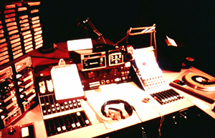 On-air studio at Radio Victory in 1976 |
||||
|
+ Radio Victory, June 22, 1976 Eugene Fraser and Dave Symonds. |
||||
| + The Kenny Everett Show on Radio Victory, September 26, 1976 | ||||
|
+ Radio London May 2, 1966 Mark Roman. |
||||
| + Radio London, July 7, 1967. John Peel's Late Night show "The Perfumed Garden" | ||||
|
+ Radio Jackie, Aug 14, 1977 Memories from the British offshore radio era. Phil Hazleton. |
||||
 |
||||
|
+ Britain Radio - Phil Martin's "Morning Serenade",
Saturday, December 17, 1966, at 9 am. |
||||
|
+ Invicta Radio, August 1988 Sarah Whatsername. |
||||
| + Radio Caroline South - Keith Hampshire's"Keefers Uprise" morning show, Saturday, December 24, 1966, at 4 minutes past 8 am | ||||
|
+ Radio Scotland - Tony Meehan (not The Shadows member), Tuesday, November 22, 1966 |
||||
|
+ Swinging Radio England Johnnie Walker on a Saturday morning at 02.25, August 13, 1966 |
||||
|
+ Wonderful Radio London Tony Windsor at 08.25 am, Saturday, November 19, 1966 |
||||
|
+ Radio Dolfijn Peter van den Hoven, unknown date. |
||||

|
||||
| + Radio Luxembourgh, August 8, 1990 Tony Murrell in stereo via satellite at 21.25-00.10. 2 hours 35 min. | ||||
|
+ Radio London date?, year? Tony Blackburn in a recording where he's imitating the sound of the station. |
||||
| + Downtown Radio 20 yrs Jubilee, March 16, 1996 - the first independent local radio station in N. Ireland (Belfast). | ||||
| What
Can We Learn About The Scandinavian Pirates? Here are the four complete parts of Philip Champion's series of articles (in English), published in the printed magazine, Radio Review, about the Scandinavian Offshore "pirates". Part 1: Radio Nord - published in December 2012 Part 2: Radio Mercur - published in April 2013 Part 3: DCR, Danmarks Commercielle Radio May 2013 Part 4: Radio Syd - published in August 2013 |
||||
| + BBC Transcription Disc Brian Matthews presenting The Top Of The Pops, week 21, 1965 | ||||
| + BBC Transcription Disc Brian Matthews presenting The Top Of The Pops, recorded May 21, 1965 | ||||
My interest in radio began when I was five, and it grew even stronger when I, in my early teens, experienced Radio Nord - a Swedish offshore radio station that lasted for 16 months in the years 1961 and -62. On the picture on top to the right you can see Radio Nord's beautiful broadcasting ship, the MS Bon Jour, which much later, after Radio Nord's shutdown in 1962, eventually became the broadcasting ship MV Mi Amigo of Radio Caroline.
I started this website in 2006 with the ambition to offer something much better than the other radio web sites provide, and also when it comes to telling the story of this broadcasting ship. I have seen many other sites where they are trying to provide that story, but they have told it a little superficial, I think. So here is my version, and I will start way back in the start of the Radio Nord project. While you read, feel free to test my selection of offshore radio recordings in both left and right columns.
The project was financed by Texan venture
capital, and the driving force behind, setting up the station, was the
American radio entrepreneur Gordon McLendon
(1921-1986).
In America he had created the Liberty Broadcasting System
, which would eventually become the second largest radio network in the
United States. It also became known for setting new standards for daily
sports coverage in Major League Baseball to 458 affiliated radio stations.
In 1947, Gordon and his father bought a license for the radio station
KLIF 1190 in Dallas, a station that was to
become the prime example of American Top 40 radio.
In Sweden in those days there was a rigid radio monopoly and that had been the order for thirty years. In this regard, Sweden would continue through further more than 30 years to be the most stubborn of all European countries. How did Gordon get the idea to create commercial radio in Europe, and why, of all countries, did he choose Sweden? There are several possible reasons, but the foremost was the Swedish-Finnish businessman Jack S. Kotschack (1915-1988).
Jack had moved to neighboring Sweden in 1944 after five years as a front soldier in the Finnish Winter War of 1939-1940, and then in the "Continuation War" (1941-1944), where he also was awarded several medals for bravery. In his younger years in Finland, he had played for the national team of bandy, and he also distinguished himself as a skilled tennis player. His university studies were completed in Helsinki in 1932, and then followed three years at Herne Bay College in England where he also initiated a short but successful career in boxing, and he made it to the college championship which he also won.
 Jack's
involvement in sports had often helped him in his business contacts. During
a business trip, Jack had visited Gordon in Dallas. Their actual intention
was to discuss a film project. Gordon had a film studio and Jack had been
in the business for several years with the company Svea Film
in Stockholm.
Jack's
involvement in sports had often helped him in his business contacts. During
a business trip, Jack had visited Gordon in Dallas. Their actual intention
was to discuss a film project. Gordon had a film studio and Jack had been
in the business for several years with the company Svea Film
in Stockholm.
After a while, their discussions began to move from film to radio.
They both shared an equal interest in sports, and the main event at the
time was the upcoming World Heavyweight Championship in New York, where
the Swedish heavyweight champion, Ingemar Johansson, was to meet Floyd
Patterson.
Several months before the game, the Swedish Broadcasting Company made it clear that they would not broadcast the match. One argument was that they felt they were unable to resist a public opinion, which saw boxing as grossly dehumanizing. It was, admittedly, a minority, but the arguments they put forward were perceived as more powerful than the sport itself. Moreover, there was another important factor: this was about pro sports! The latter was then a controversial issue, and several of Sweden's top athletes had therefore been excluded from competitions.
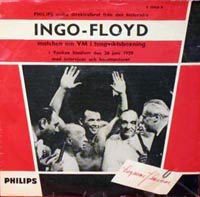 |
|
+ Radio Luxemburg |
|
+ a Philips 45 RPM disc highlights from the match. |
|
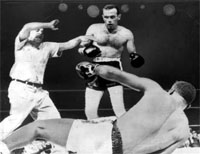 |
The Ingo match was considered by many as the game of the century. Another effect was that the radio monopoly became a more disputed issue than ever before - the refusal to broadcast the match caused a furious public opinion.
One person who saw a chance to use the opportunity was the manager of the Swedish section of Philips Electronics, Herbert Kastengren. He bought airtime on Radio Luxembourg and it was announced that Philips would report live from the boxing match at Yankee Stadium in New York.
The newspapers began to provide expert advices on antenna arrangements
and how to tune the radio to hear the broadcast.
Then came that night, the "Ingo Night", June 27, 1959, and millions
of Swedes stayed up from 11 p.m. when the broadcast began. Prior to the
match the broadcast offered a great artist posse from a studio in Stockholm
interspersed with interviews and telephone reports from Yankee Stadium
in New York. Many still remembers what they did that magical night, and
the success couldn't have been greater when Ingo at 3.37 a.m. knocked
out Floyd and became the first Swedish World Heavyweight Boxing Champion.
Another source of inspiration to Jack and Gordon were the events that had taken place in the narrow space of international waters between the southern tip of Sweden and Denmark. It was Radio Mercur, which had become the world's very first commercial radio station from a ship anchored on international waters. Since August 2, 1958 they had been broadcasting from the small ship Cheeta.
The founder of Radio Mercur was Peer Jansen (1930 - 1968) who had gotten the idea after hearing the Voice of America broadcasts from a ship on the Mediterranean Sea. They were broadcasting western news and culture aimed at listeners in the Eastern Bloc. Peer came to realize that they were using frequencies which had not been authorized by the International Telecommunications Union. This, however, didn't seem to bother no-one at all - except presumably those in charge in the Soviet Union.
Like most teenagers in the late fifties, Peer used to listen to Radio
Luxembourg. Through a misunderstanding, he had been led to believe that
they too, were broadcasting from a ship, anchored in the English Channel.
This he saw as an additional argument for the idea: if Radio Luxembourg
can broadcast this way - then can we! As we all know, Radio Luxembourg
had fully legal transmitters on dry land and on legal frequencies. However,
the intentions were obvious:
Through the use of broadcasting facilities installed in another country,
and by using transmitters with excessive power, their aim was to circumvent
the current British broadcasting legislation. It was a business in a gray
area - not quite pirate radio, still a form of, and was viewed badly by
the authorities in the targeted country.
A cousin of Peer, Børge Agerskov, was doing his university studies in law. He was caught by Peers ideas and took the time to study the Danish legislation on broadcasting. He found that it had completely overlooked the possibility to broadcast from a ship out at sea to a specific country, and thereby circumventing the monopoly on broadcasts from within that country. This order was equal in most countries, and Børges discoveries would later serve as an inspiration to many other offshore pirates. But it was Peer Jansen and Børge Agerskov who first of all saw the whole context.
There's no doubt that Jack and Gordon felt that the recent events surrounding Radio Mercur were inspirational and offered them great encouragement. After a lot of intense talks, Jack said, probably only as a joke or as a reckless idea, Let's make a radio station! Gordon was not lingering on the answer, he only said: OK, Go ahead, Jack.
It seemed quite simple to "go ahead", but it would prove to be an uphill struggle in which many storms blew up, both in terms of weather conditions and in harassments by government officials, or the telecommunications authority and other powerful representatives of the establishment. Such extreme actions as jammers and hijacking the ship on the high seas were actually considered.
A much more unexpected hindrance appeared when the central organization of the advertising agencies advised their members to be cautious and to avoid radio advertising. How much damage could it do to the public's trust in a brand name if it became associated with a radio station that was perceived as "bad", and what if the venture should end in a fiasco? The newspapers and journalists mainly drew up shady, negative scenarios of the new radio station because they were worried that radio advertising would mean harmful competition to the ability of newspapers to attract advertisers.
When Jack, at the beginning of 1960, began the search for an appropriate ship, he initially became interested in a salvage ship, Heracles, owned by the Neptune Company. Jack asked the magistrate inspector to conduct a thorough inspection which resulted in a positive report. Jack felt that the vessel issue thereby had been solved in a reliable way. However, Gordon's confidant, Jim Foster had been involved as “marine experts” and wanted to exercise his greater authority in the matter. He considered Heracles inappropriate - too small! Instead he advocated (the only half as large) Olga, which he had found, moored in Kiel Canal in Germany.
Bob, Gordon, Jim and Jack flew down to Hamburg and then onwards to Kiel, to inspect Jim's findings. Perhaps they had gained too high expectations, in all cases it appears to have been so for Jack. In his book, he described his first sight of Olga like this: "I think she was one of the ugliest boats I have ever seen. Small and worn she lay on the dock, scattering an intense smell of rancid herring, noticeable in a well 20 meters away". It could have been that Jack felt a bitter touch of the didactic he might have experienced from the "marine expert" Jim. However, on the long run, Jim would prove to be quite right - she really was a great ship!
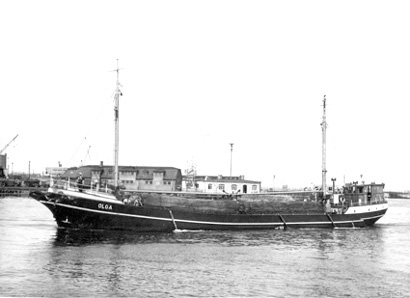
Olga, heavily loaded with cargo in the Kiel channel in
Germany
Olga was a 2-masted steel schooner of 250 gross tons, built in 1921. In its original outfit she was 30 meters long and named SS Margarethe. She was one of three sister ships - one came in use as a tug in South America and another was sold to a company in the Far East. SS Margarethe was used for cargo traffic on endless trades over the Baltic and the North Sea. Through the years she underwent several extensions of her hull. The last was performed in 1951, when she reached her final length of 41 meters including the bowsprit of three meters. From the beginning she had been a steamer but her engine was being replaced twice, the last was in 1936, when the Deutz 150bhp diesel engine was installed and became her source of propulsion for the rest of her years. After the change of ownership in 1927, she was renamed Olga after the new owner's wife. In June 1941 she was requisitioned by the German Kriegsmarine in Emden, but apparently she must have been poorly rated there; in November 1943 she was taken out of the Nazi marine rolls and was returned to her civilian owner.
On May 31, 1960 she was towed to Norderwerft, an alteration and repair shipyard in Hamburg, where she underwent a major renovation. The cargo hold was converted into crew cabins, storerooms, rooms for transmitters and space for the two heavy 60 Hz Allis Chalmers-generators, each of 93 kVA (=75kW) to power the transmitters and studio equipment. Directly below the mast was installed the two Continental Electronics 316b transmitters of either 10kW. Above what had been her hold was built the characteristic superstructure with the galley, mess and the studio techniques. She also got her name Bon Jour carved in the bow, and the hull painted in its new orange color.
On August 10 (1960), the shipyard received a message from Hamburg Oberpostdirektion where they recalled an old Hitler Law of 1937 "Gesetz gegen die Schwartzsender" which made it illegal to install, repair or perform any work at a radio station without permission from the government. Inspections were made by a posse of authority representatives - some of them were Swedes. This made it urgent to hastily move the MS Bon Jour to the Copenhagen free port Langeline for the proceeding work. The 38 meter high mast was erected on the foredeck with rigging and guy lines. They had initially ordered two identical masts and the idea had been that the antenna would be a "flat top" design between the two masts. However, Gordon had connections to an antenna expert, John Mullaney, from the American Navy. His unique antenna principle, called the folded unipole, an inverted ground plane antenna, solved the problem with the mast which actually was very far from any ideal length to function as a half wave aerial. The unique feature was that John Mullaney's antenna design took advantage of the forward and aft guy wires from the mast's top to contribute as radiation elements in addition to the mast of steel. To make this possible, it was necessary that the wires from the top were connected through carefully tweaked vacuum capacitors to ground (the hull). These special capacitors, built in metal boxes, are visible on the deck on some photos of the Bon Jour.
The most time-consuming work in Copenhagen was the installation of the transmitters. They had been delivered as a kit of 6000 parts and was put together, component by component, by Glenn Callison, chief engineer from KLIF and his assistant Archie Mesch.
On Tuesday, December 20th, 1960, it seemed as if all preparations on
Bon Jour was completed and at 6 PM they were set to leave Langeline and
begin the voyage up the Baltic Sea. Still remaining on the quay was the
second mast which had proved to be unnecessary. At 8:30, they had to anchor
because of heavy fog. At 5 on the Wednesday morning, the journey continued.
An article in Sweden's largest daily paper, Expressen, on Thursday, December
22, confirmed that Bon Jour had departed from Copenhagen two days earlier:
-The boat left Copenhagen on Tuesday for its 48-hour trip to Stockholm,
says consul Jack Kotschack. That means, if nothing unforeseen happens,
that the boat should be on its anchorage already tonight. And then, it's
just to start the broadcast.
However, it would take much longer than the estimated 48 hours because of the weather at the time. It was stiff breeze, 10 - 12 m/sec and very rough seas. Bon Jour had in this harsh weather, with her round-bottomed design combined with her high mast, a seaworthiness that got her into a terrible swinging from stem to stern. It was noticed that the stay lines on the mast were working loose. They dropped anchor to repair and adjust the rigging. Most of the men on board were unfamiliar with sea conditions and must have been at worst discomfort. In the case of a disaster there had been no ability to make distress calls; there were no radio telephone on board yet. If Bon Jour was wrecked their only chance was the lifeboat, which was equipped only with oars, no engine.
When Bon Jour, after an arduous voyage, on Friday at 11 am, at last arrived
the Stockholm archipelago, the captain choose to drop anchor at a safer
spot than the estimated near island Ornö. Instead it was at Almagrundet,
where a lightship was nearby with constant monitoring. If an emergency
should arise, it was thought that the lightship would call for assistance
through their radio telephone to the nearest pilot station. From the archives,
it has been verified that the guard on Almagrundet noted Bon Jours arrival
south of the lightship:

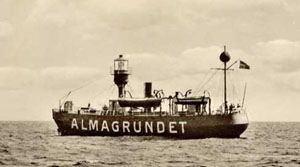
The log book from "Almagrundet" where they noted "Bon Jour,
Nicaragua" on the third row. More ![]()
At last the moment had come when the radio technicians on board could
start practical tests with the transmitter at full power. Previously,
their only options consisted of testing through a so-called dummy load,
not the real antenna mast, as that would have been a violation of the
radio laws. But now, with Bon Jour on international waters, the moment
finally arrived!
However, Glenn Callison's promises of the transmitters full functionality
became completely contradicted when a blue flash striked out between the
mast and the rigging, and the transmitter immediately went dead and silent.
Archie, Jan and Ove understood that they now had to deal with difficulties
trying to find out what had gone wrong.
The fishing boat "Dunette" had been booked in advance to search for Bon Jour on Friday - the day before Christmas Eve (in Sweden, the 24th is the important feast day of Christmas, not the 25th as in some other countries). The idea was that the "Dunette" would deliver fresh newspapers, and the newly recorded christmas premier programs - and Jim Foster, who we remember as Gordon's naval expert. When Dunette arrived at her estimated spot at Ornö her captain reported (Dunette had a radio telephone) "The Bon Jour is not in sight here". There was nothing to see except the open desolate sea - and that's the way it usually is outside Ornö. When Jack received that message, it came as a lightning strike in the atmosphere that prevailed; in the absence of the test broadcasts which s h o u l d have been started already, somewhere at around 495 meters medium wave.
Before Christmas, Jack had pre-ordered delivery of 2000 telegrams to
Sweden's most important business and official persons:
"Do you know that Radio Nord is now on the air? Turn on your
radio now and you'll hear the modern radio station!"
The Dunette continued searching for Bon Jour on Christmas Eve. But then the captain of Bon Jour had chosen the better safe than sorry solution to abandon her in his fear that the mast was going to collapse. A salvage tug had picked them up and brought them safely to Sandhamn.. It was true that it really had been in bad weather, and this was later to become even worse, up to 17 m / sec.
The captain Elis Olsson got the sack, and some have later chosen to describe
him as a lousy captain. As further evidence of his poor seamanship, they
have claimed that he was the first to abandon ship. - and even more, it
was near that one in the crew was left forgotten on board.
Or was this whole story untrue - the mistakes that he was accused of would
later prove to have its debt to the poor work done by the shipyard in
Copenhagen, and that he had actually done what was possible to rescue
the situation. The Swedish newspaper Dagens Nyheter (Daily News) on December
29, said that the captain had expressed concerns in Copenhagen about how
the work had been carried out in the yard and he had requested that the
shipyard would perform an inclining experiment, but the yard said this
was excessive.
The captain would soon prove to be completely right, but then he had already been sacked. There remained a lot of work connected with the stability of the mast's rigging. But there was further reasons to the debacle that had arisen: the transmitter that did not work, the overly optimistic expectations of a rapid premiere for Christmas. But most of the drama was because no radio telephone had been installed. None of these problems had nothing to do with the competence of the captain.
Nevertheless, a new captain was hired, and he would become very popular with everyone on board. His first assignment was to take the Bon Jour to Åbo, Finland, where she at the shipyard Chrichton-Vulcan for repairs, and mainly to get the problems concerned with her mast rigging solved.
On February 4, 1961, the Bon Jour left the ship yard, heading to her position near island Ornö, only to find that a gale began to blow up and the shp had to set off again to try to find a calmer position. While this happened, a crack was heard, folloved by a "rain" falling of small white pieces of what had been the porcelain insulators from the mast guy lines. Once again she had to limp off to make repairs, this time they choose to go to Finnboda ship yard
On photographs where you see Bon Jour straight from one of the sides you can see that the balance of the ship makes her mast tilt slightly backwards. This is caused by the fact that she was originally equipped and planned as a schooner; with two masts. Without the aft mast but with a very heavy and large mast in the bow, she tended to be a quite rocking front to back. On some pictures you can also see that a large part of the rudder remained above the water, meaning that the rudder wasn't so effective. In rough wheather conditions, Bon Jour could be difficult to control because the lines connected to the steering wheel was directly linked to the rudder - she had no power steering.
Below the bridge, which was quite far aft, were the berths for the captain, mate and chief engineer. Farther aft, lowest down, was the engine-room and the newly installed diesel generators to power the transmitters and studio equipment. These generators were electrically separated from the vessel's conventional generator for lighting, etc.
Up in the superstructure, or deck house, in its most aft end, was the galley next door to the pantry. In the next room - a small room, was a ladder down to the cabins for the rest of the crew on board. Continuing forward in the deckhouse was the washing and toilet facilities and a shower. Further forward there was a combined dining and recreational space on board. There were floor-fixed tables, comfortable armchairs and also a TV with good reception of Sweden's, then, only TV channel. At the forward rooms was the studio and a control room.
In the control room, the most dominant sight were the four large tape recorders of the American brand Exacton. Originally they had been planned to offer an ability to make programmed automatic broadcasts at night where each of the tape machines would hold prerecorded music, each song combined with an announcement and separated with green "leader" tape. A separate smaller tape recorder was for the commercials and for other prerecorded material. An automatic random switching between these four tape reels would completely avoid any repetitions of the same song combinations. The automatic switching between the tape machines was triggered by the silence occuring when a song was finished and the following leader tape was passing through, then immediately it would start the next tape machine. The tape reels would be shifted before each night. It was, for its time, a "modern" idea, but eventually the whole idea was abandoned since it had failed too often. In its most succesful events it had anyhow led to too lengthy silences between the programme ingredients. The prerecorded tapes were used at times, but then only manually. Later they changed this entire tape-rack-stand with two Ampex recorders of the same reliable model, 350b, that were used at the studios in Stockholm.
The company had employed educated professional journalists as early as October 1960. By a coincidence it happened that the day when they launched newscasts they also had something very particular to report: Russian Jurij Gagarin became the first man in space that day, April 12, 1961. The editors main working tools were the two communication receivers, one National NC-400 and one Hallicrafter SX-100 and also through a Creed RTTY teleprinter machine to receive telegrams from newsagencys such as Reuters AFP, AP, UP and UPA. The news readers listened primarily to the BBC World Service and Voice of America. They also had frequent radio telephone calls to the Stockholm headquarters to receive home news. Radio Nord was the first media in Sweden to report about the "Bay of Pigs" invasion, where a CIA-trained force of Cuban exiles made an unsuccessful attempt to overthrow the Cuban government of Fidel Castro. Another dramatic event when Radio Nord was first with the news was on September 17, 1961, when the United Nations' secretary-general Dag Hammarskiöld - a Swede - died after a plane crash between Leopoldville and Northern Rhodesia. It was a tragedy that paralyzed Sweden and the world, and it has never been clarified whether it was a political sabotage or an accident. The news was first received by the chief engineer Ove Sjöström via short wave. The news reader Lars Branje, who previously had many years of experience as a pilot of the Swedish Air Force, made a knowledgeable narrative of the dramatic event. The vast knowledge that was offered in this particular news coverage must have been difficult to other Swedish news media to beat.
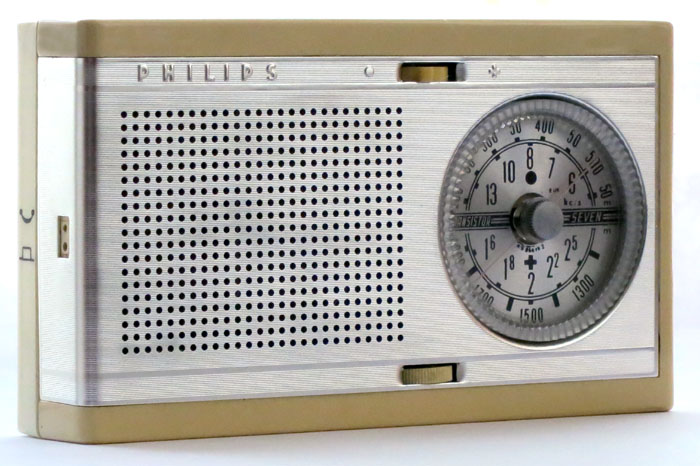
Copyright
rules for the contents of this website: You are most welcome to
use and copy content for personal, non-commercial use. On the other hand, it is strictly prohibited to use any of the material to sell in whole or partly in any way. radioarkiv@gmail.com |


